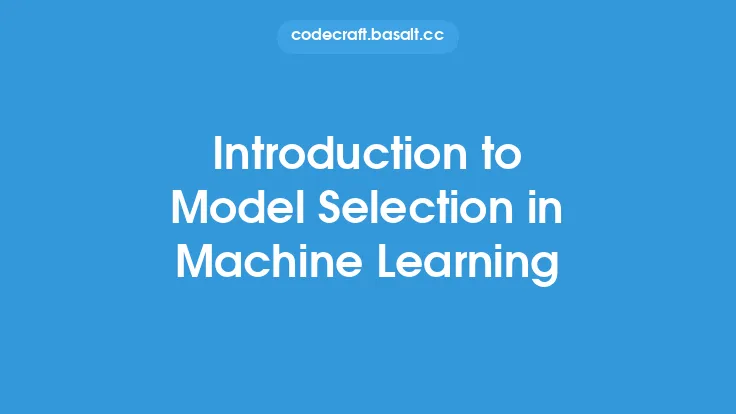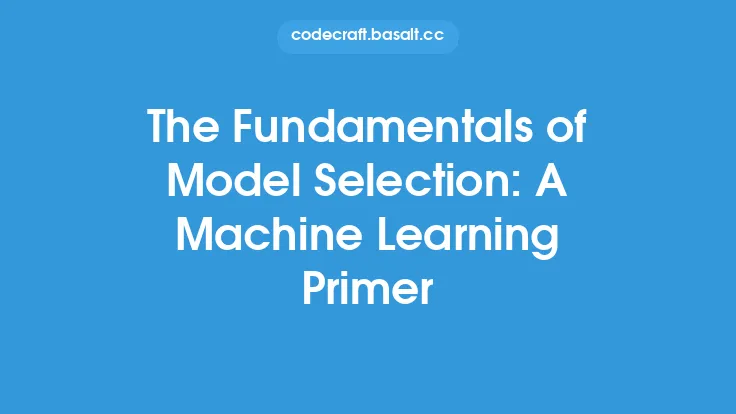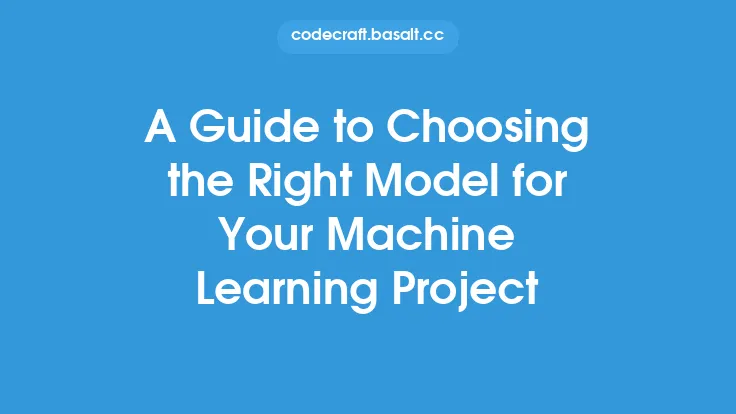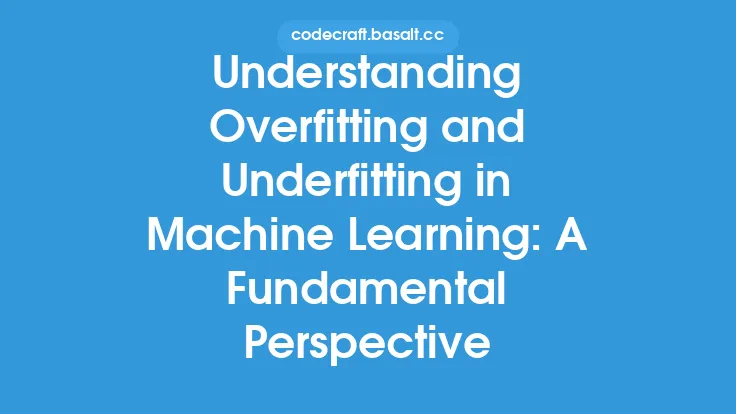When it comes to machine learning, model selection is a crucial step in the development of predictive models. It involves choosing the best model from a set of candidate models, each with its own strengths and weaknesses. The goal of model selection is to identify the model that best generalizes to unseen data, making it a critical component of the machine learning pipeline. In this article, we will delve into the best practices for model selection in machine learning, providing a comprehensive overview of the key considerations and techniques involved.
Introduction to Model Selection Techniques
Model selection techniques can be broadly categorized into two main types: traditional and modern. Traditional techniques include methods such as cross-validation, bootstrapping, and permutation tests, which are used to evaluate the performance of a model on unseen data. Modern techniques, on the other hand, include methods such as Bayesian model selection, regularization techniques, and ensemble methods, which are used to select the best model from a set of candidate models. Each of these techniques has its own strengths and weaknesses, and the choice of technique will depend on the specific problem being addressed.
Evaluating Model Performance
Evaluating the performance of a model is a critical step in the model selection process. There are several metrics that can be used to evaluate model performance, including accuracy, precision, recall, F1 score, mean squared error, and R-squared. The choice of metric will depend on the specific problem being addressed, as well as the type of data being used. For example, in classification problems, accuracy and F1 score are commonly used, while in regression problems, mean squared error and R-squared are commonly used. It is also important to consider the concept of overfitting and underfitting, where a model is too complex or too simple, respectively, and fails to generalize well to unseen data.
Cross-Validation Techniques
Cross-validation is a widely used technique for evaluating the performance of a model on unseen data. It involves splitting the available data into training and testing sets, and then using the training set to train the model and the testing set to evaluate its performance. There are several types of cross-validation, including k-fold cross-validation, leave-one-out cross-validation, and stratified cross-validation. K-fold cross-validation is a popular choice, where the data is split into k folds, and the model is trained and evaluated on each fold. Leave-one-out cross-validation is another popular choice, where the model is trained on all but one sample, and then evaluated on that sample. Stratified cross-validation is used when the data is imbalanced, and the goal is to maintain the same class distribution in each fold.
Regularization Techniques
Regularization techniques are used to prevent overfitting by adding a penalty term to the loss function. The most common regularization techniques are L1 and L2 regularization, which add a penalty term to the loss function that is proportional to the absolute value or square of the model coefficients, respectively. Another popular regularization technique is dropout, which randomly sets a fraction of the model coefficients to zero during training. Regularization techniques can be used to select the best model from a set of candidate models, by choosing the model with the smallest penalty term.
Ensemble Methods
Ensemble methods involve combining the predictions of multiple models to produce a single prediction. The most common ensemble methods are bagging and boosting, which involve combining the predictions of multiple models trained on different subsets of the data. Bagging involves training multiple models on different subsets of the data, and then combining their predictions using voting or averaging. Boosting involves training multiple models on different subsets of the data, and then combining their predictions using weighted voting or averaging. Ensemble methods can be used to select the best model from a set of candidate models, by choosing the model with the highest combined prediction accuracy.
Bayesian Model Selection
Bayesian model selection involves using Bayesian inference to select the best model from a set of candidate models. It involves specifying a prior distribution over the model parameters, and then updating the prior distribution using the observed data. The model with the highest posterior probability is then selected as the best model. Bayesian model selection can be used to select the best model from a set of candidate models, by choosing the model with the highest posterior probability.
Model Selection in Practice
In practice, model selection involves a combination of the techniques outlined above. The first step is to split the available data into training and testing sets, and then use the training set to train a set of candidate models. The performance of each model is then evaluated using cross-validation and metrics such as accuracy and F1 score. The model with the best performance is then selected as the final model. Regularization techniques and ensemble methods can be used to prevent overfitting and improve the performance of the final model. Bayesian model selection can be used to select the best model from a set of candidate models, by choosing the model with the highest posterior probability.
Common Pitfalls in Model Selection
There are several common pitfalls in model selection that can lead to poor performance or overfitting. One of the most common pitfalls is overfitting, where a model is too complex and fails to generalize well to unseen data. Another common pitfall is underfitting, where a model is too simple and fails to capture the underlying patterns in the data. Other common pitfalls include using the wrong evaluation metric, failing to consider the concept of overfitting and underfitting, and using a model that is not suitable for the problem being addressed.
Conclusion
Model selection is a critical step in the development of predictive models, and involves choosing the best model from a set of candidate models. The goal of model selection is to identify the model that best generalizes to unseen data, making it a critical component of the machine learning pipeline. By using a combination of traditional and modern techniques, including cross-validation, regularization, ensemble methods, and Bayesian model selection, it is possible to select the best model from a set of candidate models and achieve optimal performance. However, it is also important to be aware of the common pitfalls in model selection, including overfitting and underfitting, and to use the right evaluation metric and model for the problem being addressed.





